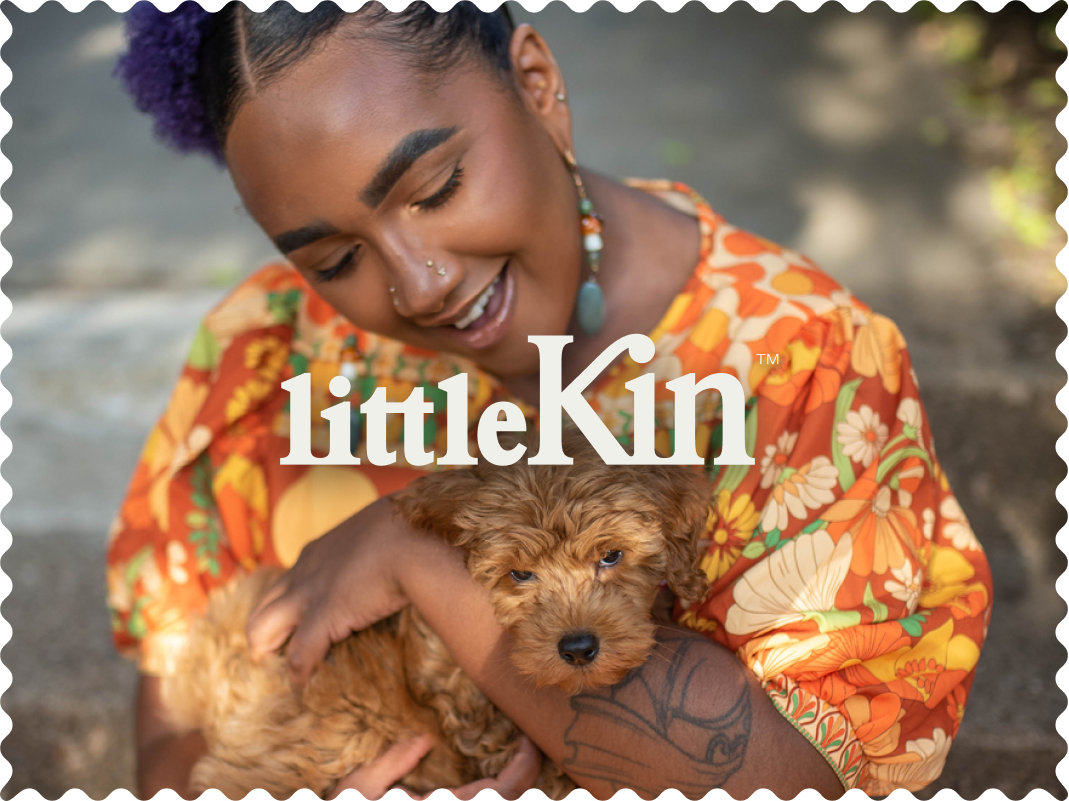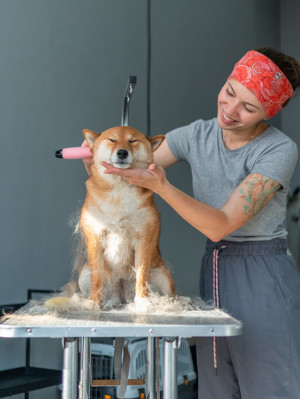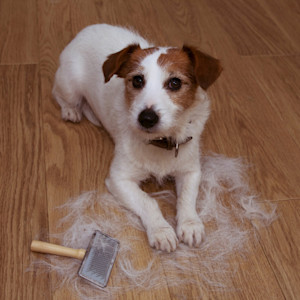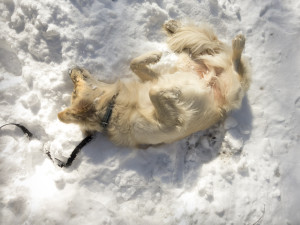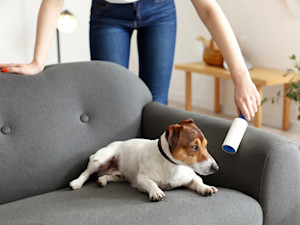A Guide to Natural Home Remedies for Dog Hair Loss
Sure, hair around your home can be frustrating, but what if your poor dog is shedding excessively?
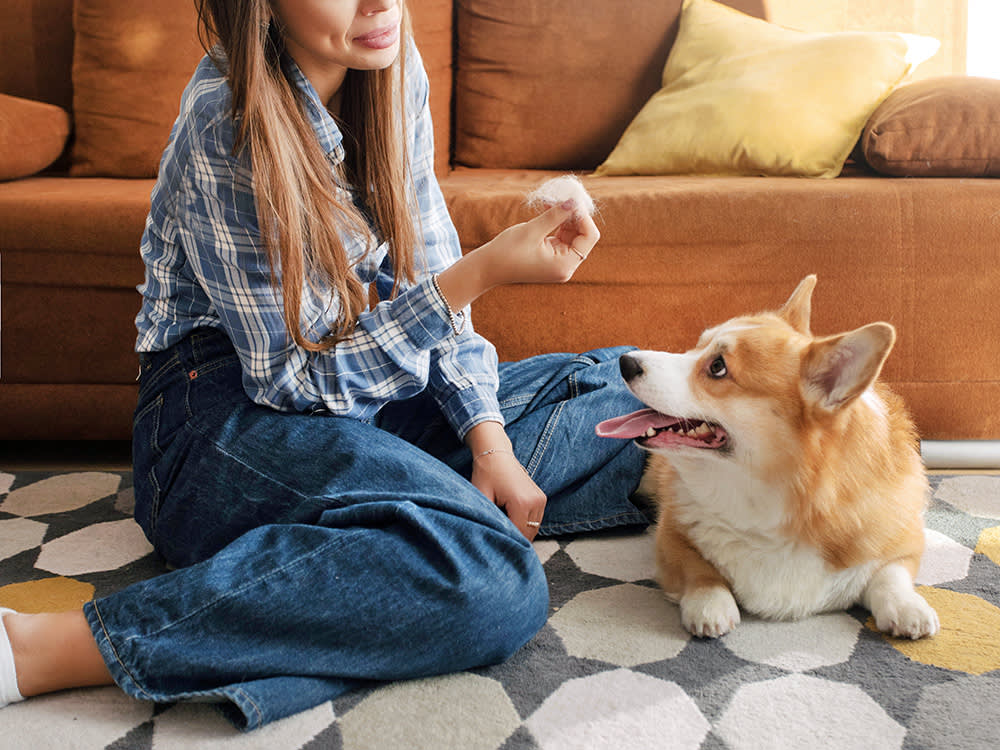
Share Article
In This Article:
What Causes Hair Loss in Dogs? Home Remedies for Dog Hair Loss How to Prevent Dog Hair Loss When to Consult a Vet
One of the not-so-fun parts of being a dog parent is the hair that finds its way onto your furniture, carpets, and clothes. Dogs naturally lose a little bit of hair regularly as each hair goes through its standard life cycle. This little bit of loss can drastically increase during the spring and fall as a dog sheds excessively to prep for their new summer or winter coat. All of this is completely normal.
What’s not normal is hair loss that exceeds regular shedding. In these cases, there are some at-home remedies that we’ll go through to help get your dog’s coat back to health. Keep in mind that hair loss in dogs can be due to a variety of causes, so you’ll want to consult your veterinarian as well to make sure your dog doesn’t have an underlying health condition.

What causes hair loss in dogs?
Hair covers the majority of your dog’s body, so it’s no wonder that a condition affecting nearly any part of their body could lead to hair loss, or alopecia. Here are some of the most common causes.
External parasites: Creepy crawlies, such as fleas or mites, can create an irritation cascade that has your dog itching and scratching their way to bald spots. You may also notice redness and small bumps, as well as adult fleas moving around.
Infections: The skin is home to many different types of bacteria and fungi. They live in a delicate balance with a dog’s immune system, keeping their numbers in check. But sometimes those numbers can get out of control and bring on itchy, smelly, flaky, or oozy skin along with hair loss.
Allergies: If you suffer from allergies, you likely know what havoc they can wreak on the skin, as well as to the eyes, nose, and even throat. Pollen, mold, and some external parasites can elicit allergic reactions that are so itchy, your dog may lose some hair.
Rashes or sores: Pressure sores on older dogs, insect bites, and foreign bodies can also create inflammatory reactions that lead to hair loss.
Genetics: Some dogs are born with the unfortunate genes that cause hair loss in parts of their body. In these cases, their skin and haircoat are perfectly healthy, just lacking in hair in some areas. Commonly affected breeds include Chihuahuas, Dachshunds, Boston Terriers, Chow Chows, Poodles, and Labs, to name a few.
Whole-body diseases: The skin is the biggest organ of your dog’s body. It’s subject to changes brought on by hormones or endocrine diseases such as Cushing’s or hypothyroidism. Dogs may develop patches of hyperpigmentation with these issues as well.
Grooming: There’s even such a thing as clipper alopecia, where patches of hair take longer to grow back after a dog is shaved or clipped. This happens in dense-coated breeds like Malamutes, Huskies, and Akitas. Aside from making a dog look funny for a little while, this type of alopecia will reverse on its own in due time.
Best home remedies for dog hair loss
Before starting an at-home remedy for your dog’s hair loss, you should get a proper diagnosis from your veterinarian. Issues such as Cushing’s aren’t going to resolve without veterinary treatment, no matter how many remedies you try. So it’s best to know exactly what you’re up against before starting treatment.
Dietary changes and supplements
Start by making sure you’re feeding your pup a diet that’s complete and balanced. It should be highly digestible and contain the recommended nutrients that your dog needs at their life stage. From there, you can start to look at some additions that may provide a little boost to benefit your dog’s skin in a big way.
Omega-3 fatty acids can cut the inflammation that may be making your dog itchy. They also work to strengthen the skin barrier to help prevent skin infections and improve your dog’s hair coat. Omega-3s can be found as an ingredient in some dog foods or can be added as a supplement.
Vitamins that most dogs need are found in good quality food, but some dogs might need a little extra to improve their hair coat and reduce hair loss. Biotin and zinc can really help expedite hair growth, and antioxidants such as vitamin E and C can help reduce skin damage for a healthier coat overall.
Topical treatments
If your dog has specific hot spots where they are losing hair, they may benefit from a topical treatment such as apple cider vinegar or coconut oil. Both are safe to apply to a dog’s skin and have natural anti-inflammatory, antifungal, and antibacterial capabilities. Coconut oil can be applied to affected areas and soak in, while apple cider vinegar should be rinsed off or diluted before it’s applied. This is because apple cider vinegar can dry out skin, potentially increasing itchiness and hair loss.
For dogs who are itchy all over, a moisturizing shampoo may work better than topical treatments. Ingredients such as oatmeal or lavender can help soothe itchy skin prone to hair loss, for a short time. Again, be sure to rinse the product out of your dog’s hair completely to prevent overdrying.
Herbal remedies
You’ll find many herbal remedies to help with canine hair loss. While some of these products are OK, some aren’t and can actually be toxic if ingested. Check in with your veterinarian before using any herbal remedies on your dog to help with their hair loss.
How to prevent dog hair loss
Dogs will lose some hair at all times — it’s just part of the deal. But when that hair loss becomes excessive, you want to curb it. After your veterinarian eliminates the presence of any health issues, you can look into doing some of the following things.
Regular grooming
Ever notice how much hair your dog’s brush accumulates when you groom them? Regular brushing can help collect hair that sheds normally, so that it doesn’t get on your clothes and furniture. Grooming can also prevent tangles and mats, and remove debris that can cause skin irritation and further hair loss.
Brushing helps spread the skin’s natural oils to moisturize your dog’s hair and give it a healthy shine. It also gives you the chance to get a good look at their skin to catch issues early on.
For most short-haired dogs, weekly brushing will suffice, with a few additional sessions during heavy shedding seasons. Long-haired or thick-coated dogs will need to be brushed every few days (or even daily) to keep their hair coats healthy.
Stress management
Stress can be a major contributor to hair loss in dogs. When a pup isn’t able to manage their stress properly, they can turn on themselves, potentially creating self-induced patches of hair loss and skin irritation, as well as excessive shedding.
Stress is best managed by keeping your dog on a regular schedule for feeding, exercise, and play time. You should also stimulate their body through exercise and their mind with games, training, and interactive toys.
When to consult a vet for dog hair loss
Ideally, you’ll want to see your vet anytime your dog is experiencing unnatural hair loss. This is the best way to determine the cause and to get treatment if the reason behind it is anything beyond a little skin dryness. Additional issues, such as rashes, redness, odor, sores, or excessive itchiness, should also be addressed by a veterinarian. Additionally, if your pup’s hair loss isn’t getting better after a few weeks of your at-home remedies, or if things are getting worse, you should see your vet.
Bottom line
Dogs normally lose small amounts of hair all the time, plus large amounts during the spring and fall shedding seasons.
What’s not normal is when a dog loses an excessive amount of hair at other times of the year or is losing hair in patches.
Hair loss in dogs has many causes, for which you’ll want to get a veterinary diagnosis. After that, some at-home remedies can help.
References
Moriello, Kate, DVM. “Hair Loss (Alopecia) in Dogs.” Merck Veterinary Manual. Sep 2024. https://www.merckvetmanual.com/dog-owners/skin-disorders-of-dogs/hair-loss-alopecia-in-dogsopens in new tab.

Dr. Chyrle Bonk, DVM
Dr. Chyrle Bonk has been a mixed-animal veterinarian since 2010, with a special interest in rehabilitation. When she's not practicing or writing about veterinary medicine, you may find her exploring the outdoors with her family or tending to her cows, horses, chickens, or cats and dogs.
Related articles
![Winterizing your dog's coat - Dog laying in the snow.]()
Natural Remedies for Dry Skin: How to Help Dry Skin on Dogs
Spoiler: These at-home remedies are probably already in your pantry.
![Woman carefully cleaning a dog in a bathtub.]()
How to Groom Your Dog at Home: the Complete Guide
Spa days can happen at home.
![Woman lint rolling her couch while her dog lays down.]()
Shedding Season: How to Keep Dog Hair Off Your Couch, Car, Clothes, and Carpet
Yes, you can: Here are some tips on keeping your house clean, despite your pup’s endless shedding.
How Often Should You Groom Your Dog?
Just make sure you spell out “B-A-T-H.”
